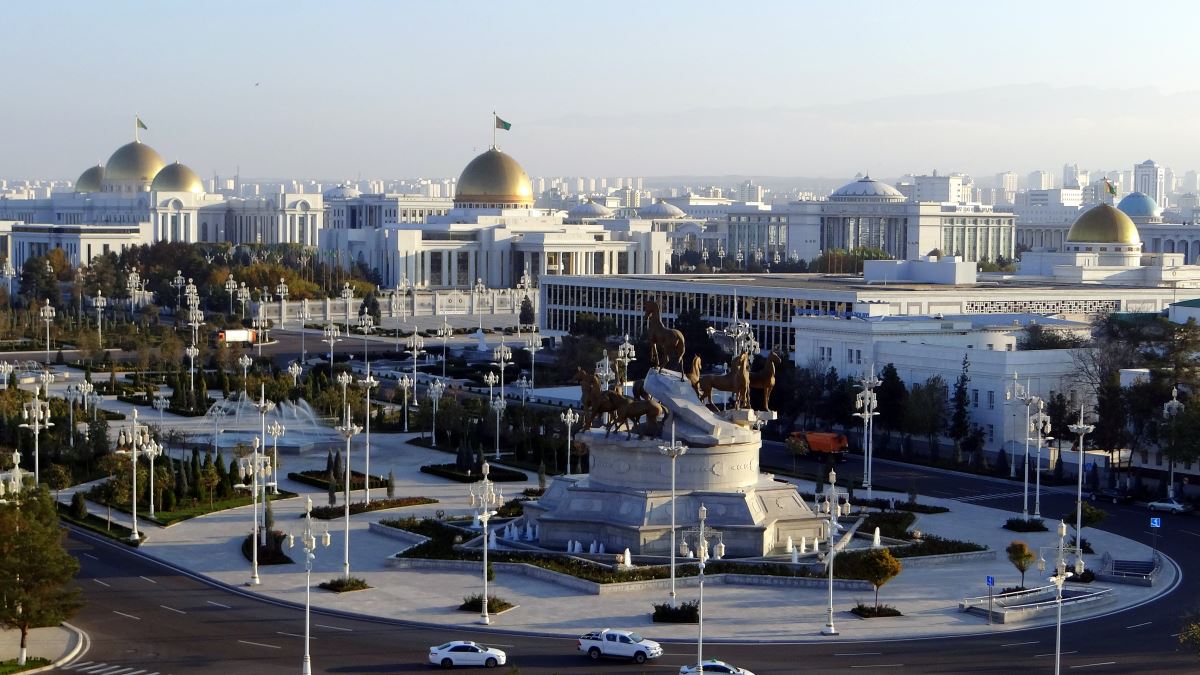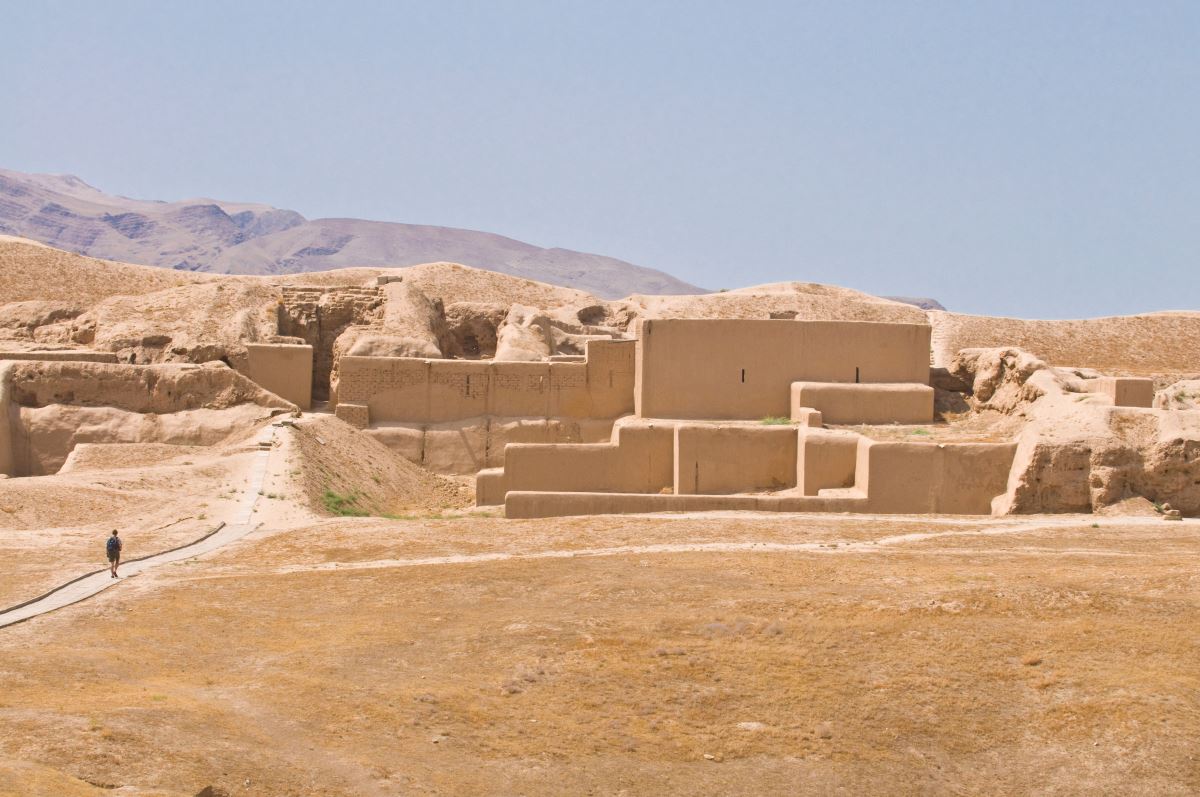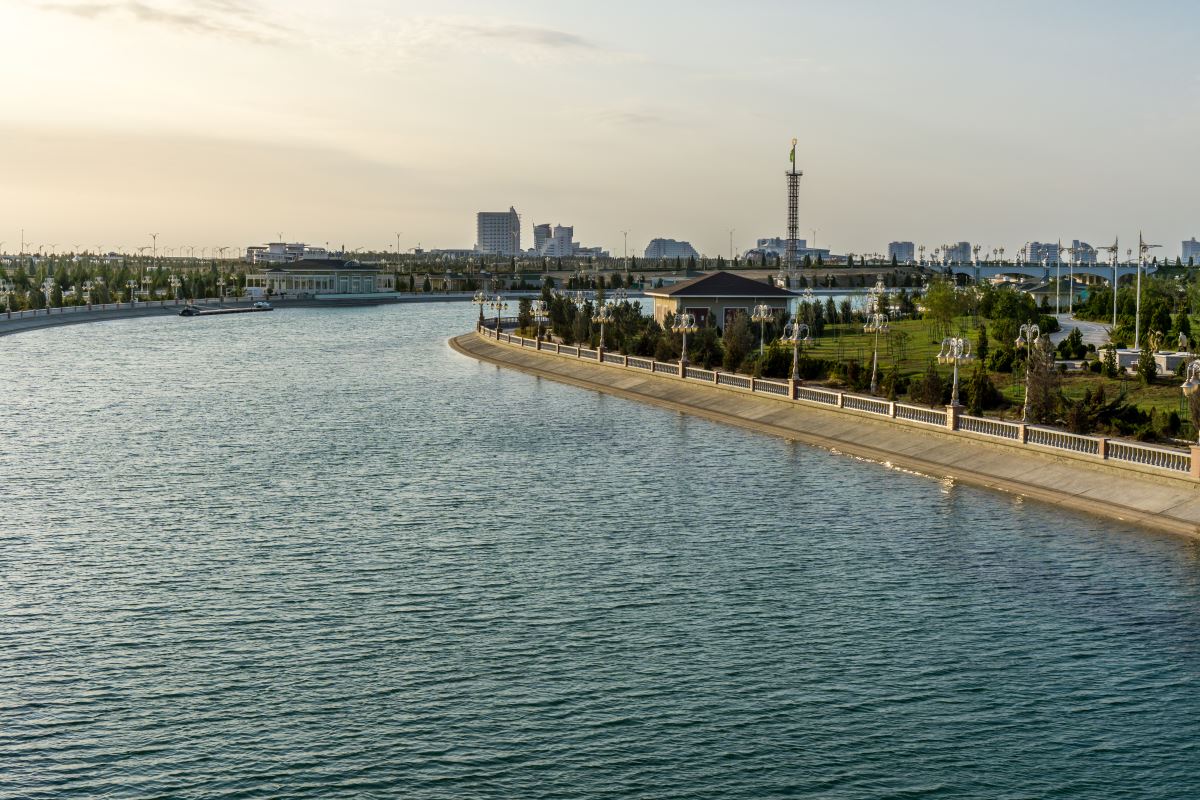The Best Things to Do in Turkmenistan Beyond the Gas Crater
The Best Things to Do in Turkmenistan Beyond the Gas Crater
When Carl Meadows, our Central Asia Travel Specialist, set out on his two-week journey through Turkmenistan, he entered a country unlike any other in Central Asia.
From its striking capital to its remote desert, Turkmenistan is a place where bold architecture, ancient history, and deeply rooted traditions exist side by side. Few travellers make it this far, and even fewer see beyond its most famous landmark, the Darvaza gas crater, but Carl travelled with expert local guides and uncovered a side of the country that rarely appears in guidebooks.
What he found was a destination overflowing with cultural depth, sweeping landscapes, enduring nomadic heritage, and religious and historical sites that chart the rise and fall of civilisations. This is a country where adventure comes naturally, whether you're exploring vast deserts, wandering through the archaeological ruins of the legendary Silk Road, or discovering a way of life that has remained largely untouched by mass tourism.
Turkmenistan isn’t a place you explore independently; travel requires planning, permits and expert guidance. But now that Carl has journeyed to even the most remote corners of this extraordinary country, you can sit back, relax and take in its wonders while he takes care of every detail.
Read on to uncover the hidden gems, unexpected moments and unique experiences that lie far beyond the Darvaza gas crater - all experienced first-hand by Carl himself.
Join our Turkmenistan group tour
1. Ashgabat
 Capital city of Ashgabat
Capital city of Ashgabat
“From the moment I arrived, the capital felt like stepping into a place that exists slightly outside of reality. Entire avenues lined with gleaming white marble buildings, grand monuments rising from perfectly symmetrical roundabouts, and parks so immaculately manicured they look hand-crafted - it’s a city that almost shouldn’t exist. Yet here it is: spotless, futuristic and utterly mesmerising.
What struck me most was the architecture. Everywhere you look, there’s something bold, striking, and unlike anything you’d find elsewhere: the towering Wedding Palace shaped like an eight-point star, the vast white-and-gold library with its orb-like centre, even a giant enclosed Ferris wheel that seems to glow at night. The scale, symmetry and imagination behind these structures make the entire city feel like a living monument.
Aside from a few free hours, you aren’t permitted to explore Ashgabat independently; tourism rules require an assigned guide, but I found this truly added to the experience. My guide helped me understand the layers beneath the surface: the pride people take in their city, the cultural symbols woven into its architecture, and the quieter corners where everyday life unfolds.
 Wedding Palace, Ashgabat
Wedding Palace, Ashgabat
We wandered through the old heart of Ashgabat, where Soviet-era fragments sit beside modern creations. Standing before the 1927 Lenin statue, with Lenin’s name still written in Arabic script, felt like discovering a relic from a different timeline. From there, we strolled past theatres, tree-lined parks and the dramatic facades that define the city.
Markets are a must. The Gulistan (Russian Bazaar) buzzes with life, while larger markets teem with everything from textiles to livestock - yes, including camels! And if shopping isn’t your thing, Ashgabat even has a British pub known locally as “Florida,” which is quite the sight in this surreal setting.
Ashgabat is the gateway to the country, but it’s far more than a transit point. It’s a city that stays with you: polished, proud and unlike anywhere else I’ve travelled.”
- Did you know? Any cars that pass through the capital must be completely white. No vehicles from the desert or surrounding areas are allowed unless they meet this rule. It’s just one of the many unusual details that make Ashgabat such a unique city.
2. Nissa
 UNESCO-list ruins of Nissa
UNESCO-list ruins of Nissa
“Visiting the ruins of this UNESCO World Heritage Site, I was struck by how it feels both timeless and surprisingly intimate.
Once a thriving Parthian trading hub, Nissa was only inhabited for a relatively short period, yet its remnants hint at a city of remarkable scale and sophistication. Walking through the stone foundations and crumbling walls, I could almost picture the bustle of merchants and travellers along the Silk Road.
What makes Nissa truly stand out is the way it connects culture and landscape. The ruins sit within wide, open plains that stretch toward distant hills, a setting that invites reflection and a sense of adventure. It’s off the beaten path, away from the usual tourist circuits, but that remoteness only deepens the authenticity. You’re not just observing history; you’re walking through the land that shaped it.
 Nissa ruins
Nissa ruins
Nearby, the echoes of Turkmen literary and philosophical heritage, like the statues of Magtymguly Pyragy, serve as reminders of the enduring cultural heartbeat that runs through the country. For me, Nissa encapsulates everything I love about Turkmenistan: authentic connections to history, striking landscapes, and a sense of discovery that rewards those willing to explore beyond the obvious.”
3. Turkmenbashy & Avaza Coastal Development
 Turkmenbashy
Turkmenbashy
“I flew into Turkmenbashy from Ashgabat, a small port city on the Caspian, and its quiet character immediately struck me.
With fewer than 100,000 residents, it’s a multi-ethnic town that still carries traces of its Soviet past: the railway station, a bustling local bazaar, and even the small Japanese cemetery, where prisoners from World War II are laid to rest. Walking through the streets, I felt a sense of everyday life unfolding in a way that’s rare for travellers in Turkmenistan; this is an authentic, lived-in city that hasn’t been polished for tourism.
Avaza
But then comes Avaza. A short drive along the coast, and suddenly you’re in a completely different world. It’s a purpose-built resort area, gleaming with pristine beaches, fountains, and a strange, futuristic energy. There are dozens of hotels, parks, and cafés, all arranged with meticulous order, giving the whole area a surreal, almost dystopian feel. Walking along the promenade, it’s easy to feel as though you’ve stepped into a vision of the future, yet it’s deeply Turkmen in character. For the adventurous, a quick swim in the Caspian is an option, and even in October, the water is bracing enough to feel like a proper adventure.
The contrast between Turkmenbashy and Avaza is what makes this corner of the country so fascinating: one moment you’re exploring a quiet, authentic city, the next you’re wandering through a hyper-modern seaside complex that feels almost like a mirage in the desert. Both are uniquely Turkmen, and together they give a glimpse of the country’s intriguing layers.”
4. Yangykala Canyon & the Western Karakum Desert
Yangykala Canyon, Karakum Desert
“Driving into the western Karakum Desert toward Yangykala Canyon, I felt like I was entering a completely different world.
The desert stretches endlessly, golden and austere, with nothing but the occasional settlement or solitary camel to mark human presence. The road itself feels like part of the adventure, winding past dunes, rugged plateaus, and the vast emptiness that gives the desert its dramatic sense of scale.
Then, Yangykala appears on the horizon: a riot of colour carved into the cliffs, streaked with deep reds, oranges, and pale creams. From a distance, it looks almost surreal, like a painted backdrop for a film. Walking through the canyons, the scale is staggering - the cliffs tower above you, and every turn reveals new angles and textures, some jagged and raw, others smooth from centuries of wind and erosion.
Camels in Karakum Desert
What struck me most was the combination of natural grandeur and solitude. Unlike other famous landscapes, this one isn’t polished for tourists. It’s rugged, raw, and breathtakingly quiet; an authentic corner of Turkmenistan that rewards patience and curiosity. The changing light of late afternoon casts long shadows and makes the colours glow in a way that feels almost otherworldly.
On the way back, we stopped at Kow Ata, a subterranean lake tucked inside a cave. The sulphur-rich waters are warm and inviting, and stepping inside the cave feels like entering a hidden world beneath the desert. It’s a surreal, almost magical contrast to the open expanse of the Karakum, and a perfect spot to pause and soak in the quiet beauty of this harsh, captivating landscape."
5. The Sleeper Train
 Karakum Desert
Karakum Desert
“When I boarded the sleeper train from Ashgabat to Mary, I quickly realised it wasn’t just transport – it was an experience in its own right.
Although we only travelled during the day, the journey felt special. As the train rolled out of the capital, the vast openness of the Karakum Desert unfolded almost immediately, a landscape so expansive it seemed the horizon had no end.
 Quiet village of Turkmenistan
Quiet village of Turkmenistan
As the sun began to set, the windows filled with warm bands of gold and deep copper, casting long shadows over dunes and solitary villages that passed quietly in the distance. It was one of those rare moments in travel when time seemed to stand still. You settle into the gentle sway of the carriage, sip tea from small glass cups, and watch the desert change colour.
What I loved most was how naturally it brought travellers and locals together. People share snacks, stories, and smiles, and even without many shared words, there’s a sense of companionship built on simply moving through the same landscape. It’s comfortable, unhurried, and authentic, exactly the kind of off-beat adventure that makes Turkmenistan such a compelling place to explore.
By the time we reached Mary, I felt as though I had seen a side of the country impossible to glimpse from the road or the air. The train didn’t just take me somewhere new - it deepened my connection to the journey itself.”
6. Mary
Local market in Mary
“Mary felt completely different from Ashgabat the moment I arrived. Where the capital is polished and futuristic, Mary has a quieter, more lived-in character, a place where daily life, history, and culture meet in a far more grounded way. It’s the perfect base for exploring one of Turkmenistan’s greatest treasures: ancient Merv.
However, for me, Mary wasn’t just a stop on the way to Merv, it was a place that deepened the entire journey. A city shaped by history, quiet in its confidence, and full of cultural touchpoints that make Turkmenistan so compelling to explore.
Before heading out to the ruins of Merv, I visited the Mary Museum. Even a short visit helped bring the region’s past into focus: artefacts, architectural fragments, and Silk Road history that gave me a sense of scale before stepping into the desert city itself.
.jpg) Russian Orthodox Church in Mary
Russian Orthodox Church in Mary
From there, I wandered past a small Russian Orthodox church from 1900, still lovingly maintained by the city’s ethnic Russian community. It’s slightly worn around the edges, but that only adds to its appeal. Nearby, an old MiG fighter jet stands proudly on a plinth, another reminder of the layers of history tucked into this unassuming city.
Mary’s Gök Bazaar was where the city truly came alive for me. It’s colourful, atmospheric and wonderfully chaotic in the best way. Spices, textiles, fresh produce, chatter; this is where you feel the cultural richness of the region unfold.”
7. Merv
The ancient Silk Road city of Merv
“Unlike many Silk Road cities that have been rebuilt or absorbed into modern settlements, Merv exists largely in ruins, and that is precisely what makes it so compelling.
Spread across 1,200 hectares near the modern town of Bayram-Ali, the remnants of this once-powerful trading hub stretch across the desert like a “wandering city,” with layers of ancient, medieval, and post-medieval settlements visible side by side. As I walked through Erk Kala and Gyaur Kala, it was easy to imagine the buzz of merchants and caravans, even though the wind now whispers over crumbling walls and empty streets.
The scale is staggering. Forts like Big and Little Kyz-Kala, built between the 6th and 9th centuries, rise stoically from the sand, while the 12th-century mausoleums of Sultan Sanjar and Muhammed ibn-Zeyd remain elegant, solemn markers of Merv’s past grandeur. Standing among these ruins, the desert stretching to the horizon, you feel the enormity of what this city once represented: a pivotal point on the Silk Road, a place where cultures collided, and ideas, goods, and religions spread across continents.
Ruins of Merv
Merv’s ruined state gives it a haunting beauty. It’s not polished, it’s not reconstructed, and you don’t just visit it, you move through it, connecting with a past that has endured despite the centuries. For me, exploring Merv was like walking through time itself, a reminder of the impermanence of human endeavour and the enduring power of the landscape that cradles it.”
Do you want to follow in the footsteps of Carl and experience the hidden treasures of Turkmenistan?
We have a Classic Turkmenistan Group Tour, where you can join Carl and like-minded travellers to delve into its highlights, from the gleaming Ashgabat to the time-worn ruins of Merv. All travel arrangements are pre-planned and handled by our team, so you can focus on soaking in every sight.
Carl’s Top Tips for Travelling to Turkmenistan
Architecture of Turkmenistan
Visas & Documentation – Let Regent Handle the Paperwork
Almost all travellers to Turkmenistan will need a visa, which requires a Letter of Invitation (LOI)—the key document that officially permits entry. Don’t worry, though: at Regent, we take care of the entire process for you. From applying for the LOI to guiding you through the visa application, we handle the bureaucracy so you don’t have to lift a finger.
All we need from you at the time of booking is a high-quality passport scan, a passport-style photograph, and a few basic personal details. Once your LOI is ready, we’ll advise you on how to use it to obtain your physical visa, either in advance at the embassy or upon arrival in Ashgabat. We also strongly recommend keeping a few printed copies with you while travelling; your Regent guide will ensure you know when and where you’ll need them. Bottom line: Turkmenistan may have a reputation for complex bureaucracy, but with Regent Holidays, the paperwork is completely taken care of; you just focus on packing and enjoying the adventure.
What to Pack for Turkmenistan
I recommend sturdy walking shoes, clothing suitable for varying temperatures, a shawl or headscarf for women, and sun protection. Practical extras like a torch, travel towel, insect repellent, wet wipes, hand sanitiser, and swimwear will also make your trip smoother and more comfortable.
Money
Cash is king in Turkmenistan, so bring crisp, clean USD notes to exchange locally. Credit and debit cards are rarely accepted, so don’t rely on plastic for everyday spending. Be prepared to navigate the official exchange rate, which your local guide will happily advise and assist with.
Connectivity
Turkmenistan is a very isolated country, and many websites and apps simply don’t work. Local SIM cards are possible to obtain, but the process can be time-consuming. Even where Wi-Fi is available in hotels, it can be patchy and slow. This is a great opportunity to embrace a little digital detox - think of it as part of the adventure!
Expect the Unexpected
Tour itineraries in Turkmenistan may change at short notice due to local conditions or access permissions. Travel here requires flexibility, patience, and a good sense of humour, especially when it comes to desert roads, domestic flights, or long trips to places like the Darvaza Gas Crater. Keep a spirit of adventure, and you’ll be rewarded with experiences that are both unique and memorable.
Eating & Drinking in Turkmenistan
Most meals are included on your tour, though some dinners are left optional to give you the freedom to explore local restaurants and try new dishes. Alcohol is generally excluded, so plan accordingly and embrace the local flavours, it’s all part of the Turkmen experience!
Embark on Your Turkmenistan Adventure
Experience Turkmenistan your way with a completely tailored itinerary shaped around your interests, pace, and sense of adventure. Whether you want to explore ancient Silk Road cities, venture deep into dramatic desert landscapes, uncover authentic nomadic heritage, or discover the nation’s striking modern identity, Regent will create a personalised journey that brings this extraordinary country to life.